|

by Stephen Meher
From
The Land of Osiris by Stephen Mehler
Adventures Unlimited Press, 2001 -chapter 15
The topic of the myth of
Atlantis has been the focus of varied books
and inquiries ever since Plato brought the concept to the Western
world in two of his Dialogues, The Timaeus and The Critias, written
in the fourth century BC. Plato claimed the story was passed down to
the Greek statesman Solon by Egyptian priests. Several other Greek
and Roman authors also related similar stories of a great ancient
civilization that perished in a series of cataclysmic earth changes.
The story of a great flood has been found in the mythology and
literature of almost all peoples world-wide, which has convinced
many authors that it was a real event. In their book Cataclysm!,
British science historian D. S. Allan, along with geologist and
anthropologist J. B. Delair, presents an effective case for the
possibility of a world-wide cataclysm occurring very near in time to
Plato’s dates for the fall of Atlantis around 11,500 years ago.
From my extensive research and interest in metaphysics, I became
aware that Plato’s Atlantis story and stories of even older
civilizations, such as that of
Lemuria in the Pacific Ocean, are
accepted parts of the Western metaphysical tradition.
Groups such as,
-
the Rosicrucians
-
the Freemasons
-
the Theosophical Society
-
the Association of Research and Enlightenment
-
the Order of the Golden
Dawn
-
the Poor Knights of The Temple of Solomon (the Knights
Templar)
...have all accepted the myth of Atlantis as a real event that
occurred in time and space.
In the early 1970s when I first discovered the works of Edgar Cayce
and his channelings about Atlantis, I became very interested in the
subject and read many books, especially those of Ignatius Donnelly,
Robert Stacey-Judd and Manly P. Hall. Cayce’s channelings were
fascinating and detailed, and based on the accounts of his life
story, he seemed to be a very credible source. The linkage of
Atlantis to ancient Egypt was also particularly strong in Cayce’s channelings, and for a while it seemed logical to me in my research
in its early stages in the 1970s that Egypt had arisen as a result
of a migration of advanced beings from the doomed Atlantic island
continent.
It is also somewhat interesting that Mark Lehner, so
often mentioned in this book as one of the strongest proponents of
the accepted paradigms of academic Egyptology and highly doubtful of
the existence of any previous Khemitian civilization before the
dynastic periods, started his career as a follower of the
channelings of Edgar Cayce and wrote a book in 1974 in which he
supported the story of Atlantis and an ancient Khemitian prehistory.
In 1979, when I first heard the tape of the lecture given by
Dr. J.
O. Kinnaman, it was his declaration that he and Sir Flinders Petrie
had found “proof” of Atlantis with ancient records and
anti-gravitational machines in the Great Pyramid that so fueled my
interest in his life and work. It was Kinnaman’s declarations that
were the final “key” for me, that obviously Atlantis had been a
reality. It seemed early in the twentieth century, before Cayce had
even channeled any information linking Egypt and Atlantis, that Kinnaman and Petrie had found the physical proof!
Of course, it
could be argued quite the opposite since Kinnaman did not discuss
this information in public or private before the 1950s and Petrie
apparently never publicly discussed any such alleged finds, that
Kinnaman only made the story up after the publication of Cayce’s
readings in book form. This argument has been presented to me often
by skeptics of Kinnaman’s claims, and quite frankly, it cannot be
refuted at this time. Since I have stated that Kinnaman claimed he
and Petrie entered into an agreement with the governments of Egypt
and Great Britain never to divulge the finds in their lifetimes, it
remains speculation.
However, there was another claim of Kinnaman’s that has recently,
due to the work of Christopher Dunn, appeared to have some
justification. Kinnaman stated that one of the uses of the Great
Pyramid was to serve as a giant radio station to send messages all
over the earth. Kinnaman claimed there was a passageway off of the
secret entrance they found on the south-east corner of the Great
Pyramid that led to a spiral staircase that took them down over
1,000 feet into the limestone bedrock. There, in a large room lying
on a stone table was a giant quartz crystal ground convex that was
30 feet in every direction (long, high, thick etc.). This giant
crystal with thousands of prisms inserted in it was the source of
the radio transmission.
One of the researchers who has been very supportive of the
possibility of previous high civilizations existing over 10,000
years ago has been David Hatcher Childress. A prolific writer and
world traveler, Childress has authored several books about lost
cities around the world. In his book Lost Cities of North and
Central America, Childress mentions finding an article in a 1960s
edition of Arizona Highways magazine which revealed that
Egyptian
artifacts had supposedly been found in the Grand Canyon in 1909, and
the story had been written up in the
Phoenix Gazette newspaper.
Childress set out to investigate and found copies of the newspaper
articles in a public library. Sure enough, the story was front page
news in the Phoenix Gazette for two days running in April of 1909.
These front page articles discussed the discovery of a cave in the
Grand Canyon in Arizona containing Egyptian mummies and artifacts.
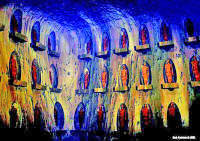 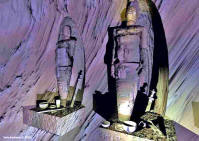 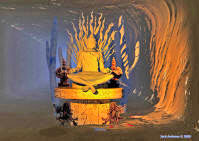
3D computer rendering by
Jack Andrews
The find was supervised by a Professor
S. A. Jordan of the
Smithsonian Institute, but when Childress called the Smithsonian to
attempt to verify the discovery, the head archaeologist and other
officials of the Smithsonian denied knowing about any such
excavation or artifacts. In fact, the Smithsonian archaeologist
stated categorically that no Egyptian artifacts had ever been found
in North America, and there never had been an S. A. Jordan who was
associated with the Smithsonian. In the Denver Museum, I was able to
locate back copies of the Smithsonian’s annual reports. I did not
find the year 1909, but in the 1911 report, the name S. A. Jordan
was listed as a field archaeologist for the Smithsonian Institute.
In a discussion I had with Dr. A. J. McDonald, President and
Executive Director of the Kinnaman Foundation in 1994 about
Childress’ revelations of an Egyptian find in the Grand Canyon, Dr.
McDonald related to me that one of the places Kinnaman had stated
radio messages from the Great Pyramid were sent was to the Grand
Canyon in America. Now, again, it is possible as an informed
archaeologist Kinnaman may have known about the Grand Canyon find in
1909, and even known Professor S. A. Jordan, and just connected the
discovery to the Great Pyramid, but it remains an interesting story
nonetheless.
We also now have Christopher Dunn stating that by virtue of the
Great Pyramid acting as a coupled oscillator, tremendous amounts of
microwave and radio wave energy were produced. So, indeed, the
Great
Pyramid could have functioned as a giant radio station, just as Kinnaman said it did.
Hakim has stated on many occasions that the
indigenous tradition has taught that one of the many functions of
the Great Pyramid was as a giant communication device--again linking
our three sources together in a new paradigm of the Great Per-Neter.
Now I can also weave other disparate pieces of information together
into a coherent tapestry. In 1992, I engaged in a series of
protracted discussions with Hakim on the subject of Atlantis. At
that time he presented a very dim personal view of the myth of
Atlantis, a pose which, quite frankly, greatly surprised me. He
stated there was no real “proof” of the myth and Plato may have
fabricated the story of Solon receiving the information from
Egyptian priests. When I brought up Edgar Cayce and the Western
mystery school traditions of Atlantis, Hakim stated that they all
were just following Plato’s lead. The motivation Hakim expressed for
taking this stance was the way the Atlantis myth was used, to
indicate that, “Non-African people created the monuments” (i.e., the
Pyramids, Sphinx, etc.).
Hakim objected to the possibly racist way
the myth of Atlantis had been utilized, namely, “an enlightened
group of white people” escaping a dying continent and civilization
came to Africa and taught “ignorant, backward indigenous peoples the
trappings of civilization.” I should mention that it was clear that
Hakim was expressing his opinion of the way the myth had been
utilized to promote a racist sense that Africans were not capable of
creating high civilization without a Caucasian boost. I have
mentioned that Hakim is a vigorous Afrocentrist, and his opinion of
the Atlantis myth reflected that stance. Hakim adamantly adhered to
his belief in the indigenous Khemitian tradition that Khemit was an
advanced civilization and the cradle of humanity, and did not need
“Atlanteans” nor anyone else to teach them how to build pyramids and
other stone structures.
As one who had been deeply immersed in the Rosicrucian and Western
mystery school tradition for many years, I was disturbed by Hakim’s
stance. I pondered over our conversations for many years without
broaching the subject again with him. However, after Hakim’s public
emergence as an indigenous Khemitian wisdom keeper and master, I
brought the subject up again in 1997. At that point, I posited a
variation on the theme. As we had already engaged in lengthy
discussions of ancient Khemit and the Bu Wizzer sites, I proposed to
him that the myth of Atlantis was a mythologue, that is, a general
story passed down that referred to the Global Maritime Culture that
existed before the “flood,” before the cataclysm of 11,500 years
ago, a civilization that was centered in Northern Africa, in ancient Khemit.
I further proposed that if there indeed was a continent of
Atlantis in the Atlantic Ocean off the coast of Africa, it was
connected to Khemit, both by trade and tribal bloodlines, and not in
any way a separate, more advanced civilization. Hakim was pleased
with the postulation and had no problem with an “Atlantis theory” if
ancient Khemit was a major part of the equation. This theory sits
very well with me, too, as I now believe the Atlantis story relayed
by Plato (who was an Initiate of Khemitian mystery schools and the
indigenous tradition) was, indeed, referring to Khemit by utilizing
the theme of Egyptian priests relating the story to Solon, and there
were other reasons for his version. One of those reasons may have
been that Plato, as an initiate of the Khemitian tradition himself,
was bound by oath not to divulge the whole story and to protect
those still keeping the tradition alive in the dynastic Khemit of
his day.
I now also believe Dr. J. O. Kinnaman may have been using the
general Atlantis myth in the same way. Perhaps having found evidence
of the ancient Khemitian civilization, he then equated that evidence
with the known myth of “Atlantis,” also connecting it all with the
Masonic tradition he was a part of. In other writings, Kinnaman had
indicated he knew that ancient Khemit was much older than orthodox
Egyptologists believed. In presenting this story to a group of
Masons, Kinnaman may have used the myth of Atlantis as a catch
phrase, as Plato had done, because he knew the time was not ripe for
the indigenous Khemitian tradition to be revealed (even to Masons!).
Now, Christopher Dunn has brought more information into this
tapestry of Atlantis. Dunn discusses in his book the reliefs that
are found in the underground crypts at the Temple of Hathor in
Dendara of Upper (south) Egypt,
reliefs that indicate the Khemitians
were perhaps aware of the principles of electricity.
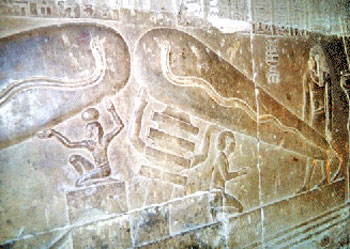
Dendara.
Temple of Hathor.
Reliefs in lower crypts of temple
possibly
showing knowledge of electricity by depicting ancient Crookes tubes.
The Temple of Hathor at Dendara where these reliefs appear is a
relatively late dynastic temple, dating from the Ptolemaic Period,
ca. 100 BC. In one particular panel of the reliefs in the lower
crypts, a baboon is shown holding two knives up in front of the
apparent giant light bulbs (Crookes tube), perhaps deflecting the
flow of electrons.
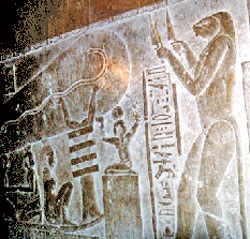
Dendara.
Temple of Hathor.
Relief in lower crypt showing Isdes
(baboon, companion of Thoth)
holding knives in front of possible Crookes tube.
Many authors have attempted to interpret these reliefs, such as
Joseph Jochmans and Moira Timms, but none has had complete access to
the indigenous tradition. Hakim states that what is shown on these reliefs was not knowledge of electricity known to the dynastic
Khemitian priests who had them carved, but a previous understanding
of energy known to the ancient Khemitians long before the dynastic
periods. He further stated that the baboon, a companion symbol of
Djehuti, Thoth, the Neter of wisdom, was holding the knives as a
warning. What was being shown was a knowledge of energy known to and
utilized by the ancient Khemitians that could be, and had been,
abused and misused.
Hakim’s explanation of the Dendara reliefs leads us to return to
Christopher Dunn’s observations inside the Great Pyramid. It has
also led to a coalescence of what Dunn stated in his book and what I
have proposed in the previous chapter. As mentioned, Dunn has stated
he has seen evidence that chemicals were used to produce the
hydrogen generated by the Giza Power Plant. Dunn bases his theory on
several observations: the first being salt encrustations deposited
around the southern shaft on the south wall of the so-called Queen’s
Chamber, which he believes to be the place where the chemicals were
mixed and the reaction occurred, thereby leaving the salt as residue
of the reaction.
He also states that the presence of the
two shafts
entering into the chamber were not for the conveyance of a dead
king’s soul (as believed by Egyptologists and even alternative
theorists), but for the conveyance of the two chemical solutions,
proposed by Dunn as possibly being an anhydrous zinc solution and
dilute hydrochloric acid. The resulting reaction would produce
hydrogen gas and zinc chloride precipitating out as a salt, thus
explaining the salt encrustation on the walls of the Queen’s
Chamber. Dunn also mentions the dark-stained walls of the northern
shaft of the chamber, possibly where the acid was deployed and
reacted with the limestone walls, indicating two different chemical
solutions were used and why two shafts were created.
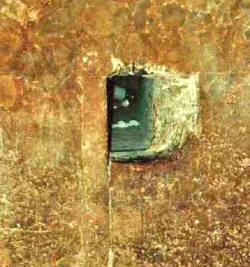
Northern shaft in Queen’s chamber showing dark stains on limestone
walls.
Support for Chris Dunn’s theory that acid may have been used
to produce hydrogen gas in Great Pyramid
Dunn then proposes an “accident” occurred, an explosion in the
King’s Chamber that virtually ended the utilization of the Great
Pyramid as a power plant. In his theory, the chemical reaction took
place in the Queen’s Chamber and the hydrogen gas was then delivered
to the King’s Chamber, which resonated in acoustical harmonic
resonance with the hydrogen, greatly amplifying and intensifying it.
But one day the reaction got out of control, and a great explosion
occurred, ending the process. Evidence for the explosion mentioned
by Dunn is the bulging out of the granite walls of the chamber and
cracks in the granite beams in the ceiling.

Cracks in granite ceiling of King’s Chamber.
Egyptian Government has
since repaired these cracks. Photo taken in 1992
Egyptologists have explained the cracks in the granite as the result
of an ancient earthquake, but as Dunn points out, the evidence for
earthquake damage is not consistent. There is no evidence of
earthquake damage in the Descending Passage leading to the
subterranean chambers, which goes into the limestone bedrock and
which would be much closer to the epicenter of an earthquake and
should show much more damage than that of the King’s Chamber much
higher up in the internal structure of the pyramid.
Upon reviewing Dunn’s preliminary manuscript (at his request) prior
to publication in 1998, I must admit his theory presented some
problems. Already having decided, from the influence and insistence
of Hakim, that water, Asgat, was the source of the hydrogen and
energy of the Great Pyramid, I was greatly impressed with Dunn’s
logic and observations and had to reconcile these apparently
divergent theories. My own personal observations in the Great
Pyramid in 1997 and 1998 had led me to agree with Dunn that an
accident had indeed occurred in the King’s Chamber. The walls of the
chamber do obviously bulge out and can be seen to be separating from
the floor. I have taken photographs of the ceiling cracks, and no
one else but Christopher Dunn has attempted to explain the
discoloration of the granite stone box (erroneously referred to as a
“sarcophagus”) in the chamber. Cut from Aswan rose granite, the box
today is a chocolate brown, not the natural color of the granite.
Dunn proposes the discoloration is from the accident, a great
explosion that caused a chemical reaction in the granite, greatly
darkening its color.
Now I can weave this tapestry together and present a hypothesis
tying in the last chapter and what I have stated so far in this one.
I propose, synthesizing the works of Viktor Schauberger, Johann
Grander, Christopher Dunn, and the indigenous teachings of
Abd’El
Hakim that indeed water was the original medium and source of energy
of the Giza Power Plant. When the Per-Neter was originally completed
as a functioning power plant, in my opinion well over 20,000 years
ago (Kinnaman had stated he and Petrie found “proof” the pyramid was
over 36,000 years old), water was the source of the power,
catalytically converted to oxygen and hydrogen in a beautifully
controlled implosion reaction.
In our lengthy discussions on the subject, Christopher Dunn had
proposed a dilemma for me. If water was the original source for the
hydrogen gas used by the Giza Power Plant, then why were there two
shafts in the Queen’s chamber, the reaction chamber, when only one
would be necessary if water was the medium used. The answer came to
me after long hours of meditation and thought on the subject.
Browsing through my many books with scenes of the temple reliefs, my
eyes stopped on one scene which provided the answer.
A familiar
scene on many Per-Ba (temple) walls depicts the “king” as the
realized initiate, being anointed with water by two of the Neters,
Djehuti (Thoth) and Horus. I have called this scene “The Two Waters”
and have seen it over and over again since the initial revelation.
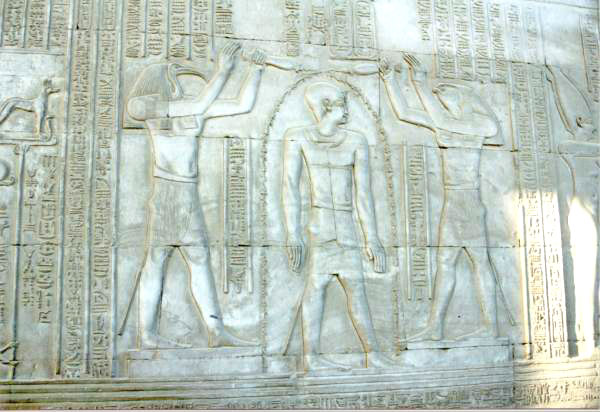
Kom Ombo.
Temple of Sobek-Horus.
“The Two Waters”, depicting king
anointed with water by lunar principle,
Thoth (left) and solar
principle, Horus.
In the spirit of Schauberger’s elucidation of many different
types
of water, it has become obvious to me the Khemitians also recognized
different waters and were depicting two specific ones in these
scenes. Djehuti, although depicted as a male Neter, is a Lunar,
feminine principle, wisdom (wisdom is also feminine in the Tibetan
tradition). Horus is a Solar Neter, a masculine principle (perhaps
that of compassion, as in the Tibetan tradition). It now became
clear to me why Hakim had spent so much time showing us two
different tunnel systems, one deep underground and the other closer
to the surface.
The reason for two shafts to deliver the water into
the Queen’s chamber is that two types of water were utilized:
-
a cold
water coming from the underground Nile, through the tunnels under
the Giza Plateau, lunar in nature, feminine
-
a heated water
coursing closer to the surface through basalt and granite and
charged with solar power, masculine in energy, coming through the
round and square holes cut into the bedrock for that purpose
This, then, is the meaning of Asgat Nefer in practical usage by the
ancient Khemitians. Using both feminine and masculine waters
combined provided a Nefer state to produce tremendous amounts of
hydrogen in a clean, implosion reaction. This reaction went on for
many thousands of years, with a seemingly endless supply of power by
virtue of the great pluvials, rainy periods, to produce the water
needed for the hydrogen. But something happened, perhaps great
periods of drought occurred due to radically decreased rainfall, and
the Ur Nil dried up or was radically decreased, resulting in a
depletion of the water source. Another possibility is that
consciousness declined due to the waning of the senses as the Age of Aten (The Wiser) came to a close and water was abandoned as the
source and chemicals substituted, or a combination of both. Whatever
the reason, the use of chemicals led to the staining and salt
precipitation Dunn mentions, and instead of the creative implosion
reaction (as per Viktor Schauberger and Johann Grander) of the
wondrous Asgat Nefer, a destructive explosion occurred, as stated by
Christopher Dunn.
Therefore, the crypts of Dendara may be telling this exact story of
a misuse of a great energy known to the ancient Khemitians and
warning of a possible future occurrence. I propose this explosion,
this “accident,” in the King’s Chamber may have occurred between
12,000-6,000 years ago and is a real event that was incorporated
into the myth of Atlantis. A problem that does arise with this
explanation, and which has been voiced to me in presentations I have
given over the last few years, is how could the ancient Khemitians,
being in advanced states of awareness and consciousness, have
resorted to the use of chemicals and allowed this accident to occur.
Further complications with this idea are that the 12,000-6,000 year
time frame would be in the Khemitian age of Aten, the time of full
use of the senses and flowering of consciousness. I do admit that
this is still a problem for me today, but the fact remains that the
crypts of Dendara present a warning of the misuse of knowledge and
technology and an accident did occur in the Great Pyramid.
With the
drying up of their water source, the Ur Nil, the waning of the
senses as Aten moved closer to the time of Amen, and the world
cataclysmic event occurring around 9500 BC, a collective fear could
have forced the ancient Khemitians to resort to the use of chemicals
and an explosion reaction for their source of energy and power. As
Edgar Cayce stated in his readings, Atlantis fell as the result of a
misuse of its power and technology, and a disregard for natural law.
The reliefs at Dendara warn about a past misuse of energy, the “Fall
of Atlantis.” I propose the myth of Atlantis was given to the Greeks
as a metaphor for real events that happened in ancient Khemit, and
indeed, Khemit and Atlantis were not separate civilizations.
Further explorations into the Khemit--Atlantis connection occurred
in 1999. As mentioned in the beginning of this book, I have been for
many years interested in the work of George Gurdjieff. A series of
articles written by William Patrick Patterson for Telos Magazine
entitled “Gurdjieff in Egypt” and a subsequent video released by
Patterson with the same title rekindled my interest in Gurdjieff’s
work. In his second book, Meetings With Remarkable Men, Gurdjieff
had stated that he once had seen a map of “pre-sand Egypt” in the
possession of an Armenian monk. This map had stimulated Gurdjieff to
go to Egypt and search for teachings about human origins in ancient
wisdom schools.
Patterson had also been fascinated with Gurdjieff’s travels to Egypt
and had done extensive investigations of his work. Patterson is
convinced that Gurdjieff had seen an image of the Sphinx on the map
of “pre-sand Egypt” and went to Egypt to investigate for himself. Of
course, I contend that if the map was indeed of a “pre-sand Egypt”,
it would have contained the pyramids as well as the Sphinx at
ancient Giza before the current desert conditions. According to
Patterson, Gurdjieff had stated that his teachings had come from a
complete system of “Esoteric Christianity” that originated in
ancient Egypt many thousands of years before the time of Jesus. I
met Patterson at a talk he gave in Denver, Colorado in July of 1999.
Both Patterson and I agreed that Gurdjieff might have come in
contact with the indigenous tradition over 100 years ago, especially
in his extended stay in Ethiopia. Gurdjieff adamantly maintained
that the source of all modern esoteric systems had their origins in
predynastic Egypt, essentially supporting our paradigms of ancient Khemit.
However, Patterson also mentioned other statements of Gurdjieff that
stimulated further investigations on my part. Gurdjieff had stated
in his writings and discussions that he had found inscriptions on
the walls of the Temple of Horus in Edfu, which is in the south of
Egypt, that mentioned the myth of Atlantis. In his articles
Patterson mentioned a book by British Egyptologist E. A. Reymond,
The Origins of the Egyptian Temple, in which translations of the
texts of Edfu were given. Reymond called these inscriptions “The
Building Texts” and claimed they were the myths of the origins of
ancient temple buildings.
I found Reymond’s translations of the Edfu texts to be incoherent
and poorly done and decided to discuss these texts with Abd’El Hakim
in Egypt. On our tour in October of 1999, we went to the Temple of Horus at Edfu and found the inscriptions on the walls ourselves. It
became apparent to us that the texts at Edfu were copies of much
older texts, the temple having been built in the Ptolemaic period
ca. 200 BC, and were discussing events that had taken place in
ancient Khemit many thousands of years before the temple was built.
Gurdjieff had stated that the texts spoke of an advanced people,
whom Reymond referred to by the standard Orthodox translation of the
term Neter, as “Gods” who had come from an island that had been
destroyed by a flood and had brought their wisdom to the ancient Khemitians. However, Hakim’s interpretation was vastly different. I
believe the texts are referring to the time of the ancient Ur Nil
over 30,000 years ago when the vastness of the river had turned all
of Northern Africa into a series of large islands.
As the Khemitians
became united, they moved from island to island, erecting temples
and pyramids and creating the ancient Khemitian civilization. Once
again, this became a basis for the future myth of Atlantis. Hakim
was definite that the texts were not referring to a more advanced
non-Khemitian people coming from outside Africa, and teaching the
Khemitians how to build in stone. I propose that the ancient people
followed the river from the south and the west and formed the union
of the 42 tribes in the Land of Osiris, Bu Wizzer, and other ancient
sites in the south, such as Edfu and Abydos.
The texts are therefore
describing the Khemitian’s ascension into higher consciousness,
becoming “one” with the Neters, opening their senses and creating
high civilization. The texts discuss how the “Neters arrived” from
different islands, and began the process of erecting large--scale
edifices in stone. We did not find any references to cataclysms, but
even so, the ancient Khemitians may have “island hopped” until the
42 tribes united and coalesced into a coherent civilization.
There may have been an advanced island civilization in the Atlantic
(or Antarctica, as has been claimed) that perished as a result of
the great cataclysm proposed around 11,500 years ago. But it may
also be that there were large islands in Northern Africa as a result
of the ancient Ur Nil around this same time that were populated by
an advanced civilization of ancient Khemitians. The Myth of Atlantis
may have referred to the entire Global Maritime Culture that existed
in many parts of the world prior to 10,000 years ago, much of which
was almost completely destroyed by cataclysmic events. I believe
ancient Khemit should be included in that mythology.
Ancient Khemitian priests may have entertained Greek travelers with
stories of cataclysms destroying island civilization as an oral
history of the Global Maritime Culture that once existed, knowing
full well that ancient Khemit was part of that past glory, but not
revealing the complete story to the “barbarian” Greeks.
|








